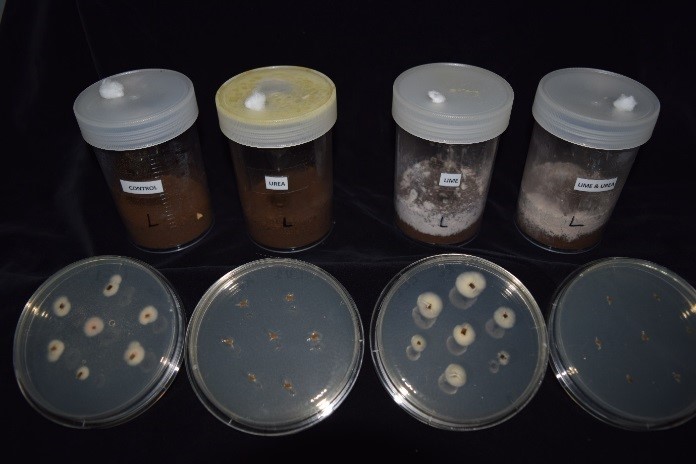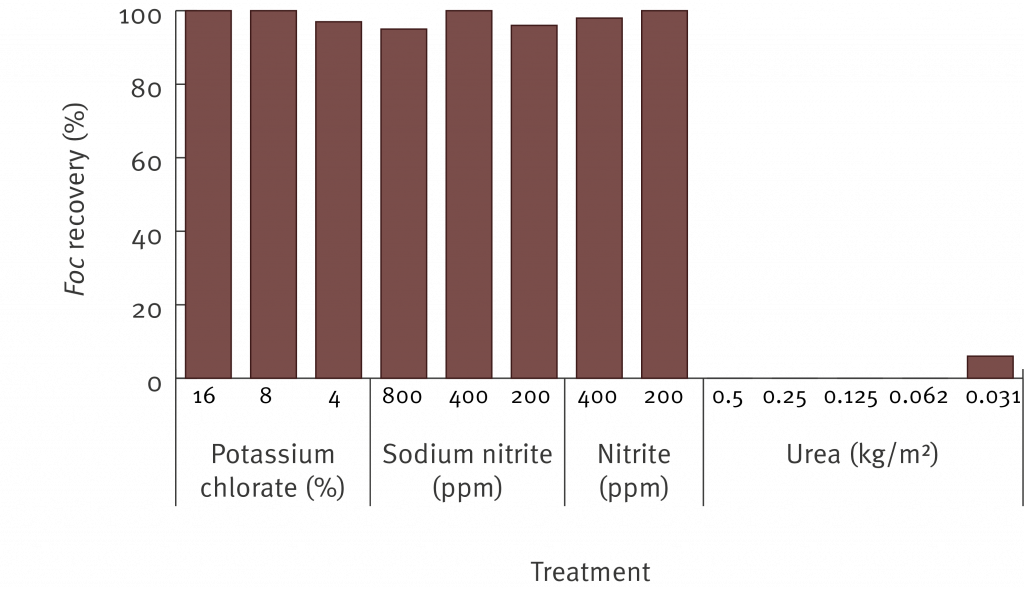Lab trials - reducing inoculum
To reduce disease inoculum levels, researchers have investigated the practice of using high rates of urea on the soil surface immediately surrounding infected plants.
Lab trials at South Johnstone used a soil bioassay with spores of Fusarium oxysporum f.sp. cubense (Foc), the fungus that causes Panama disease race 1. This was used as surrogate for tropical race 4. The inoculated soil was treated with one of the following treatments:
- ‘control’ – no urea or lime treatment
- urea (rate equal to 0.5 kg/m2)
- lime (rate equal to 0.5 kg/m2)
- both lime and urea (rate equal to 0.5 kg/m2).
Interestingly, Foc was not recovered from soil that was treated with urea and the urea/lime combination. Foc was however recovered from soil treated with lime only, proving the application of lime on its own as ineffective at reducing inoculum levels.


Outcomes...
Lab trial results have shown that both urea and the combination of urea and lime at the specified rates are effective at killing the spores that cause Panama disease race 1.
Further lab investigations
Further trial work has evaluated the effectiveness of lower application rates of urea as well as chemical alternatives that are suggested to be toxic to Foc. The same bioassay using soil in jars was used to determine the effectiveness of the following treatments:
- potassium chlorate @ 4, 8 and 16% (w/v)
- sodium nitrite at 200, 400 and 800 ppm
- nitrite at 200 and 400 ppm
- lower rates of urea (rate equal to 0.031, 0.062, 0.125, 0.25 and 0.5 kg/m2).
These investigations showed that urea applied at 0.062 kg/m2 or greater prevented Foc recovery from soil. All the other chemical alternatives were not effective at reducing the recovery rate of Foc.

Additional trials have investigated the effectiveness of different urea rates (between 0.031 and 0.062 kg/m2) and further explored alternative sources of ammonium. This time the effect of urea, ammonium nitrate + potassium hydroxide and aqueous ammonia were assessed. The trial showed that ammonia (NH3) from any source that produces a concentration equal to or above 2500 ppm was effective at preventing Foc from being recovered from the soil.
So what does this all mean?
These lab trials show the current methods for dealing with infected plants using urea (1 kg per square metre) would significantly help in reducing the amount of inoculum in infested banana paddocks. The trials further show that ammonia, rather than other gasses produced during the breakdown of urea, is likely to be responsible for the toxic effect on the fungus.
For more information about this work contact our better bananas team on 13 25 23 or email: betterbananas@daf.qld.gov.au
This trial was funded as part the Fusarium Wilt Tropical Race 4 – Biosecurity and Sustainable Practices (BA14013) project, which was funded by Hort Innovation, using the banana research and development levy, co-investment from the Queensland Department of Agriculture and Fisheries and contributions from the Australian Government. Hort Innovation is the grower-owned, not-for-profit research and development corporation for Australian horticulture.


